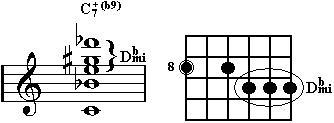Second Double Alteration: Dominant Flat 9, Sharp 5
The Dominant Flat 9, Sharp 5 chord is bi-tonal.

The bi-tonal triad is most easily seen from a 6th string root, or the Open Voicing:

Example 1: add the 2nd to the triad:

Example 2: add the 4th to the triad:

II - V - I Examples
Example 1:
Over the Dmi7 is a Dmi7 arpeggio with a 4th added. Over the G7aug (b9) is Ab Minor Pentatonic. However, the Dorian 6th (of Ab) is used (F = the 7th of the G7). E Minor Pentatonic is used over the Cmaj7 - E minor is the upper extension triad of Cmaj7 (see Extensions).

Example 2:
Over the Dmi7 I'm thinking A Minor Pentatonic. This works because the upper extension triad of Dmi9 is A minor. Over the G7aug (b9) you can think of it as above (Ab Minor Pentatonic) or you can think of it as a Db7 arpeggio or Mixolydian (Ab Dorian = Db Mixolydian), in which case you would be back to the tri-tone sub. Over the Cmaj7 I'm still thinking E minor although there is some chromaticism in the last bar.

Example 3:
The line over the Dmi7 is a Pentatonic scale. The G7aug (b9) line is a straight Ab minor 7 arpeggio. Over the Cmaj7 is an Emi Pentatonic scale.

Example 4:
As in Example 2, over the Dmi7 I'm thinking Ami. Over the G7+(b9), I'm thinking an F half-diminished arpeggio. The F half-diminished incorporates the Ab minor (see the Extensions page). Over the Cmaj7 I'm thinking E-7.
(Emi7 over C = Dmaj9. See 9th Chord Extensions).



